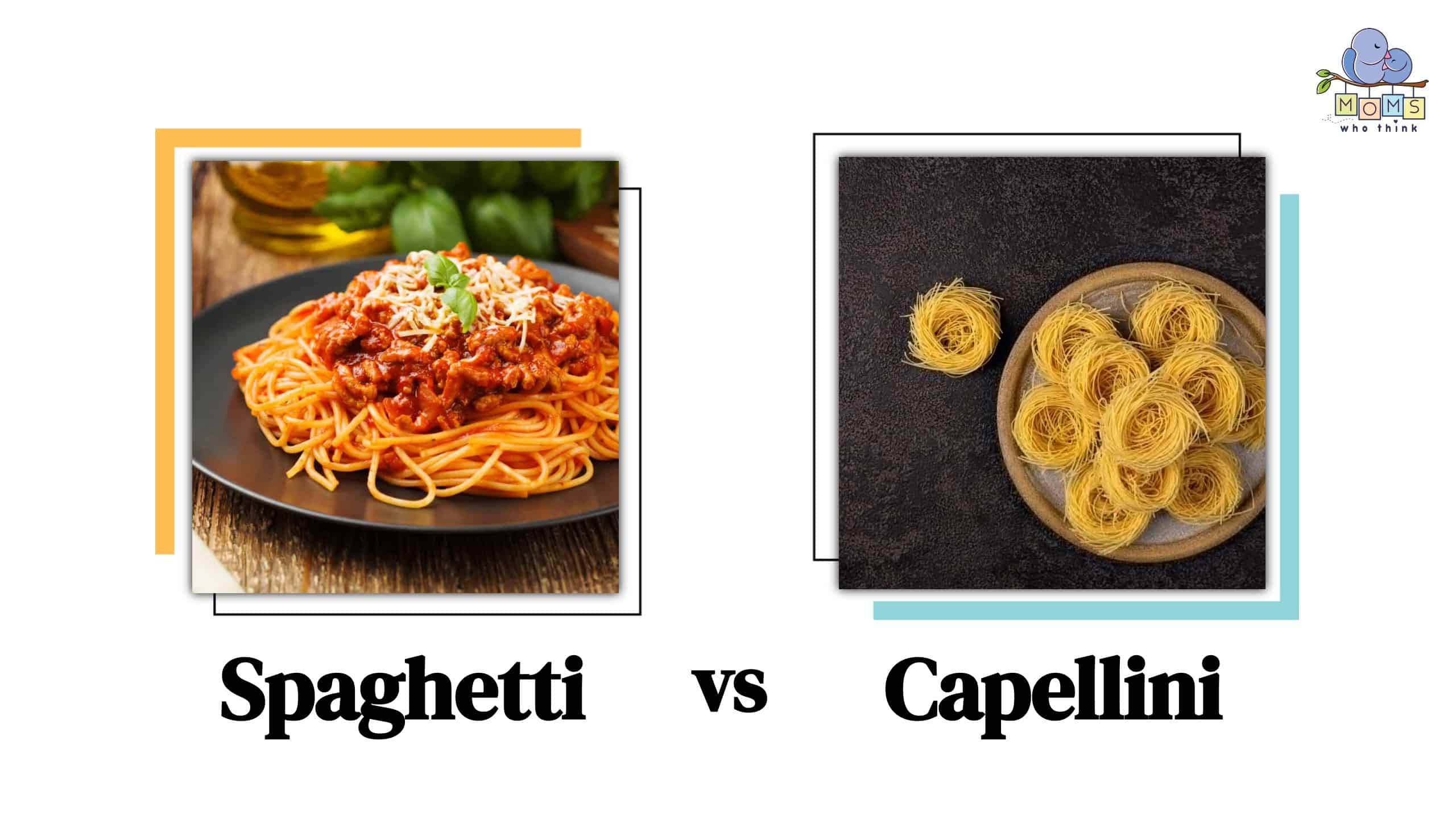The key difference between spaghetti vs. capellini is the thickness. Spaghetti is typically 1.8 to 2 millimeters thick. Capellini is about 0.85 to 0.92 millimeters thick and is one of the thinnest pasta shapes- but not as thin as angel hair. When it comes to Italian pasta, spaghetti and capellini are two of the most recognizable and adored varieties. Both of these long, thin noodles can be found in grocery stores and on restaurant menus around the world.
Despite being similar in appearance and often used interchangeably in recipes, there are key differences between the two which set them apart. In this article, we will explore the history, characteristics, culinary uses, nutritional value, and cooking techniques of spaghetti and capellini. Whether you're an experienced pasta fan or simply curious about the differences between these two popular types of Italian pasta, we hope this article will provide you with a comprehensive guide to spaghetti and capellini.
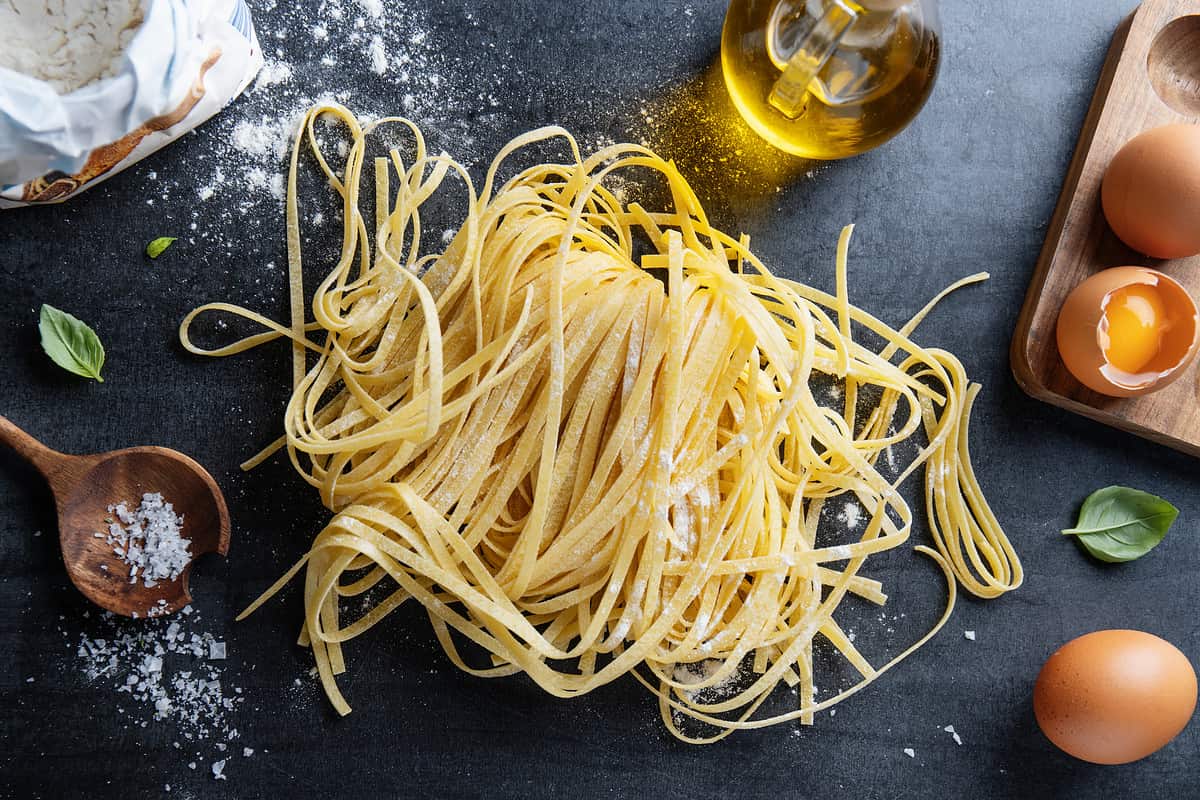
©iStock.com/nerudol
What Are Spaghetti and Capellini?
Spaghetti and capellini are both types of long, thin pasta that are very popular in Italian cuisine. They are both made from durum wheat semolina flour and water, but their thickness and shape set them apart.
How Are They Different from Each Other?
While both types of pasta are thin and long, spaghetti is thicker than capellini. Spaghetti noodles are typically around 1.8 millimeters in diameter while capellini is approximately 0.85 to 0.92 millimeters. This difference in thickness affects their texture and makes them more suitable for different types of sauce variations.
Where Did Spaghetti and Capellini Originate?
Both spaghetti and capellini have been a staple in Italian cuisine for many years, and their popularity has spread around the world. Spaghetti, in particular, has become a symbol of Italian cuisine and is one of the most widely recognized types of pasta. Spaghetti originated in southern Italy and is a traditional dish in the region of Campania. While its exact origins are unclear, it is believed that spaghetti has been popular in Italy since the 14th century and was brought to the United States and other countries by Italian immigrants.
Capellini is often confused with angel hair pasta due to its thickness. It originated in the Naples region of Italy. Its name, which translates to “fine hair,” suits its very thin shape. The history of capellini is less well-known than that of spaghetti, but it is believed to have been developed in the early 14th century.
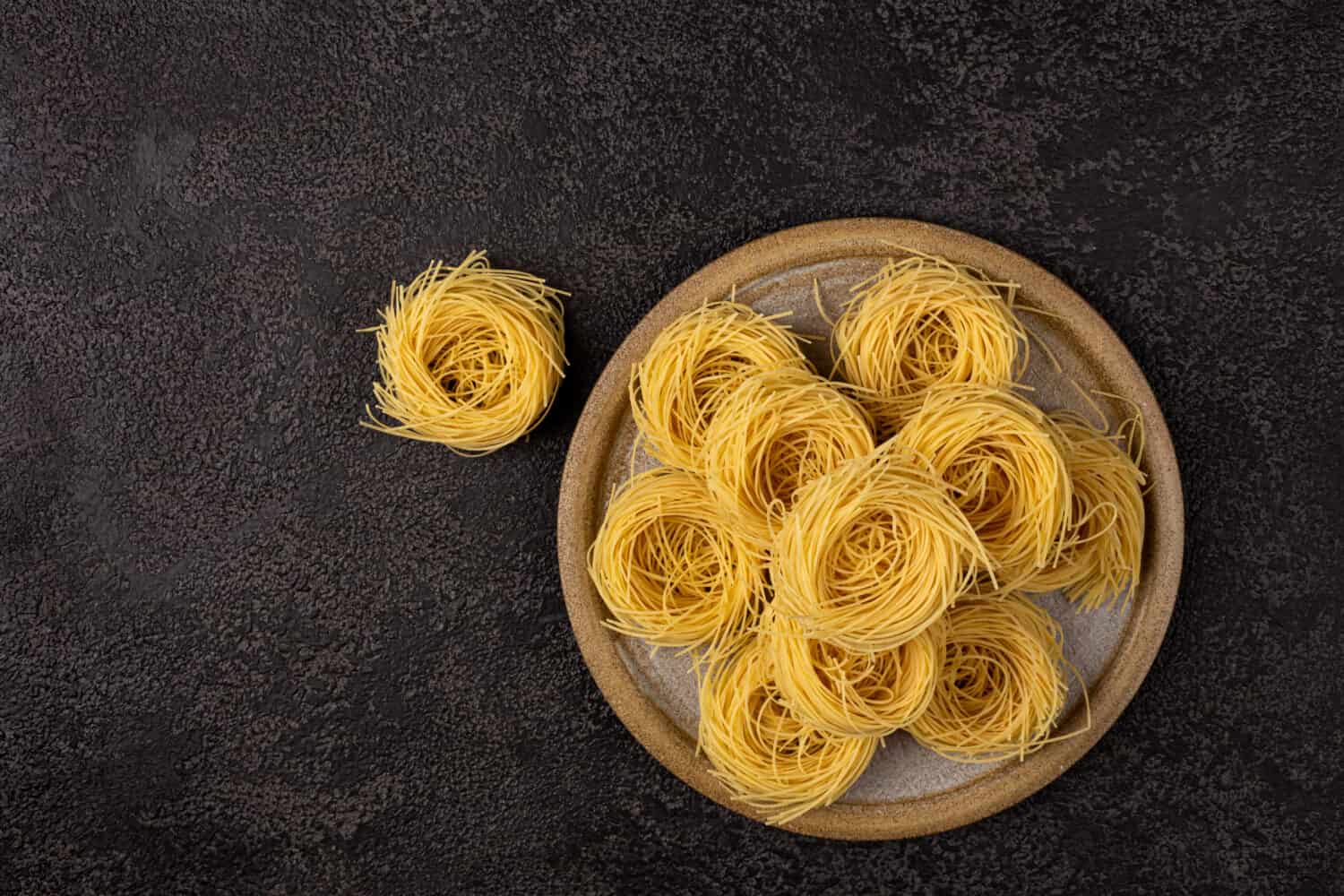
©Foodshik_ph/Shutterstock.com
What Gives Spaghetti and Capellini their Unique Texture?
The texture of both spaghetti and capellini is a result of their thin shape and the type of flour used to make them. The durum wheat semolina flour used in their making gives them a firm texture that holds up well in sauces.
Spaghetti has a chewy texture and holds onto sauces well due to its thickness. Capellini, on the other hand, has a delicate and light texture that is best with lighter sauces or served simply with olive oil and garlic. Both types of pasta are cooked al dente, which means they are cooked until just firm to the bite.
Culinary Uses and Combinations of Spaghetti and Capellini
Spaghetti is often used in classic Italian dishes such as spaghetti carbonara, spaghetti bolognese, and spaghetti alle vongole (with clams). Capellini is commonly used in lighter dishes such as capellini pomodoro (with tomato sauce) and capellini aglio e olio (with garlic and olive oil).
Spaghetti couples well with tomato-based sauces, meat sauces, and seafood sauces. Capellini is best with light tomato sauces, olive oil-based sauces, and sauces with herbs such as basil and parsley. Both types of pasta go well with parmesan cheese, garlic, and fresh herbs.
Nutritional Comparison of Spaghetti and Capellini
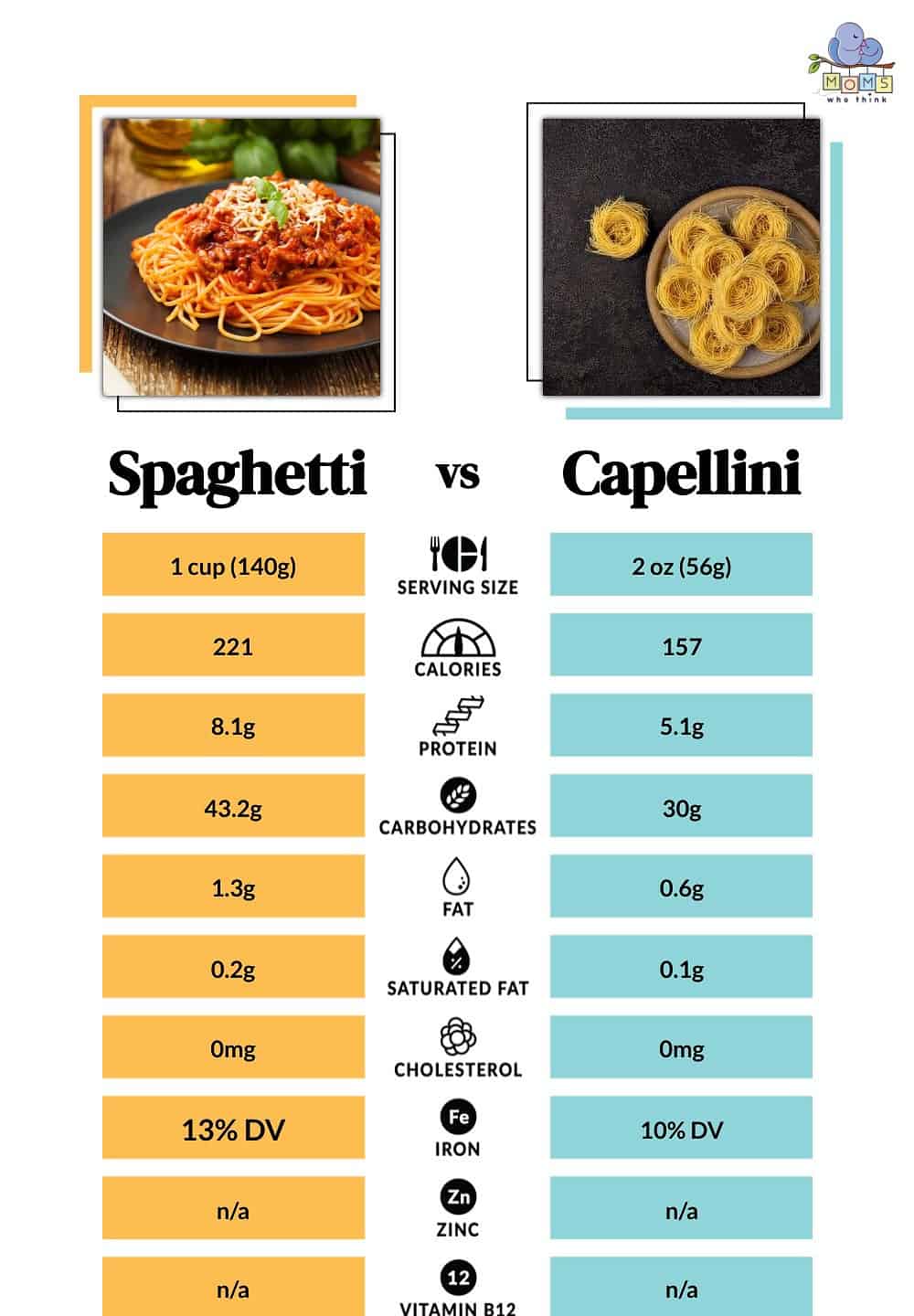
©
Health Benefits of Eating Spaghetti and Capellini
Both spaghetti and capellini are great sources of complex carbohydrates, which are important for providing energy and regulating blood sugar levels. They're also low in fat and high in protein, making them a great option for those who want to maintain a healthy diet. Additionally, the durum wheat used in these kinds of pasta contains gluten, which can help improve the texture and chewiness of the pasta and may provide some benefits for gut health. Although, if you are gluten intolerant it would be advisable to use a substitute grain which will allow you to still enjoy both Italian cuisines.
Cooking Methods for Spaghetti and Capellini
Spaghetti and capellini are both cooked in the same way: in a large pot of salted boiling water. They should be stirred occasionally to prevent sticking and cooked until al dente (as we'll discuss in the next section).
How to Cook Al Dente Spaghetti and Capellini
Cooking spaghetti and capellini al dente means that they're cooked to the point where they're still firm, but not too hard or too soft. The best way to achieve this is to follow the instructions on the package and check the pasta 2-3 minutes before the cooking time is up to see if it's reached this texture.
Avoiding Common Mistakes When Cooking Spaghetti and Capellini
One of the most common mistakes when cooking spaghetti and capellini is not using enough water. These kinds of pasta need to be cooked in a lot of water to prevent sticking and ensure even cooking. Another mistake is not salting the water enough, which can result in bland-tasting pasta. Finally, make sure you don't overcook the pasta, as this can result in a mushy and unappetizing texture.
Factors to Consider When Choosing Between Spaghetti and Capellini
When choosing between spaghetti and capellini, you should consider the texture and thickness you would prefer. Spaghetti is thicker and chewier, while capellini is thinner and more delicate. Reflect on the dish you're making and which pasta would work best with the sauce and other ingredients.
Final Verdict: Spaghetti or Capellini?
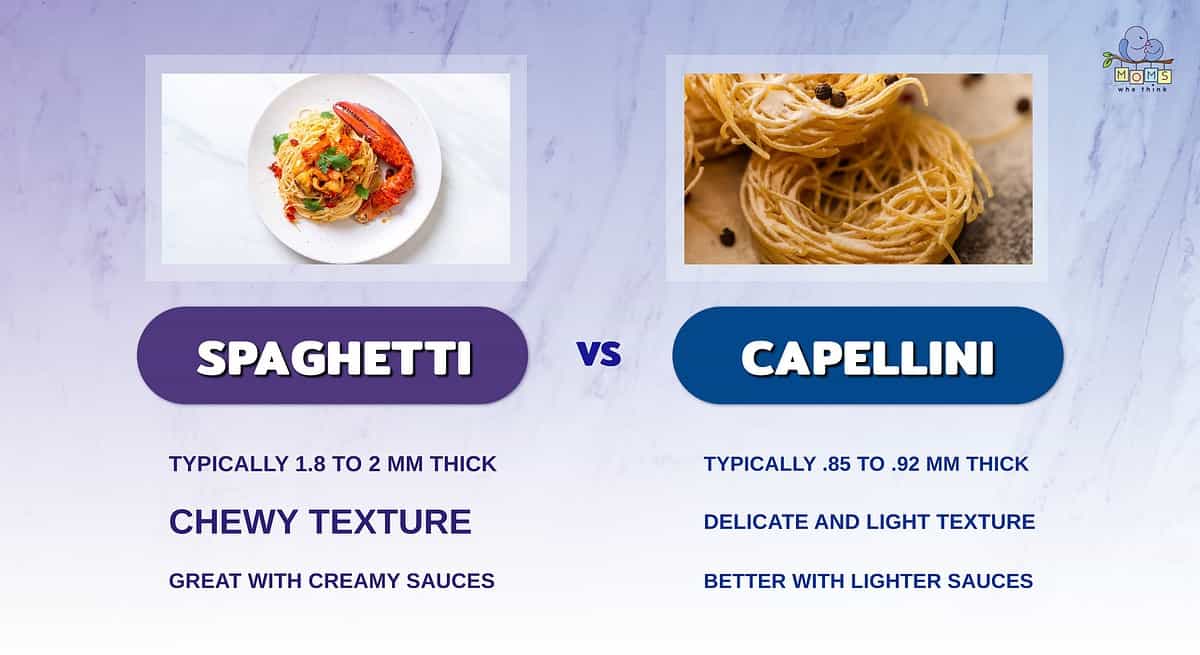
- The main difference between spaghetti and capellini is in their thickness. Spaghetti ranges from 1.8 mm to 2 mm thick, while capellini is .85 to .92 mm thick.
- Spaghetti has a chewy texture, while capellini has a light and delicate texture.
- Because of its thickness, spaghetti does better with creamy sauces than capellini. Capellini is best served with a lighter sauce, or even just oil and garlic.
There's no clear winner when it comes to choosing between spaghetti and capellini, as it depends on your personal preference and the specific dish you're making. Both kinds of pasta have similar nutritional profiles and can be cooked using the same techniques. Ultimately, it comes down to which pasta you enjoy more and which works better with your dish. In conclusion, both spaghetti and capellini are delicious and versatile types of Italian pasta that have been enjoyed for generations. While their similarities might make it tough to choose between them, understanding the differences in texture, taste, and culinary uses can help you determine the perfect noodle for your next meal. Whether you prefer the heartiness of spaghetti or the delicate nature of capellini, they will always be cherished by pasta lovers around the world.
FAQ
Can I use spaghetti and capellini interchangeably in recipes?
Yes, you can use spaghetti and capellini interchangeably in many recipes. However, it's important to note that the texture of the two noodles is different, and this can affect the overall dish. Spaghetti is thicker, and it can hold up well in hearty sauces, while capellini is delicate and perfect for light, oil-based sauces.
Is one type of pasta healthier than the other?
Both spaghetti and capellini are made from similar ingredients and have similar nutritional profiles. However, the serving size and preparation method can affect the overall nutritional value of the dish. For example, a plate of pasta with a heavy cream sauce will be higher in calories and fat than a dish with a simple tomato sauce.
Can I achieve the same texture with spaghetti and capellini?
No, the texture of spaghetti and capellini is different, and it's hard to achieve the same texture with both noodles. Spaghetti has a chewy, hearty texture, while capellini is delicate and soft. The cooking time and preparation method can also affect the texture of the noodles.
How do I know which one to use for a particular dish?
Choosing the right noodle depends on the type of dish you are making. Thicker noodles like spaghetti are better suited for hearty sauces like bolognese or carbonara, while delicate noodles like capellini are perfect for light sauces like garlic and oil or marinara.
Easy Spaghetti and Capellini Recipes for Busy Weeknights
Spaghetti is versatile and can be used in a variety of dishes, making it a great option for busy weeknights. Try making spaghetti with meatballs, spaghetti carbonara, or spaghetti with tomato sauce and garlic.
Capellini is a delicate and elegant pasta that's perfect for special occasions and dinner parties. Try making capellini with shrimp and lemon, capellini with scallops and asparagus, or capellini with cherry tomatoes and basil.
Cheesy Stuffed Meatballs with Spaghetti
Ingredients
1 pound ground beef
1/2 cup Italian seasoned dry bread crumbs 1 egg
2 ounces mozzarella cheese, cut into 12 (1/2-inch) cubes
26 ounces Pasta Sauce
8 ounces spaghetti, cooked and drained
Instructions
1. In medium bowl, combine ground beef, bread crumbs and egg; shape into 12 meatballs. Press 1 cheese cube into each meatball, enclosing completely.
2. In 3-quart saucepan, bring Pasta Sauce to a boil over medium-high heat. Gently stir in uncooked meatballs.
3. Reduce heat to low and simmer covered, stirring occasionally, 25 minutes or until meatballs are done. Serve over hot spaghetti. Sprinkle, if desired, with grated Parmesan cheese.
